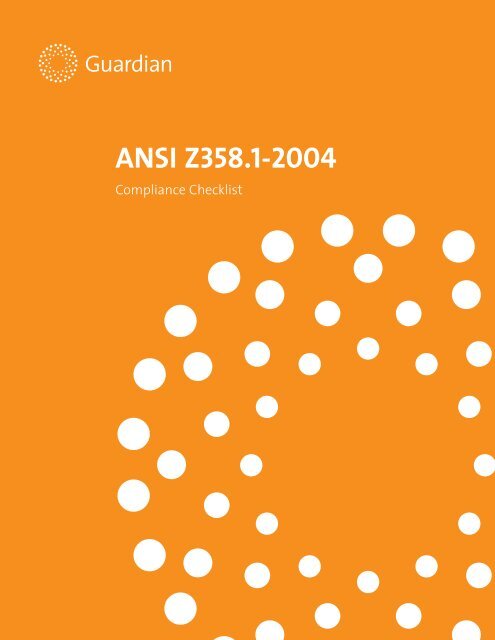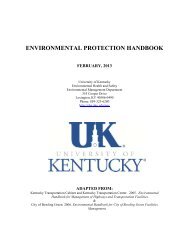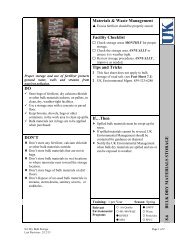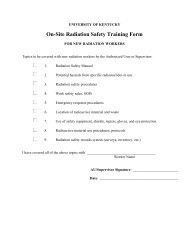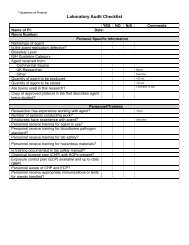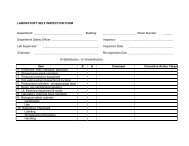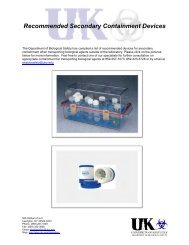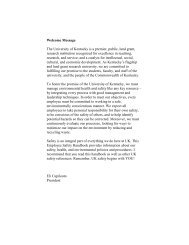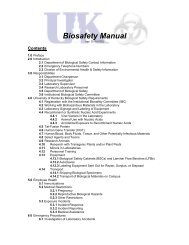ANSI Z358.1-2004
ANSI Z358.1-2004 - UK - Environmental Health And Safety
ANSI Z358.1-2004 - UK - Environmental Health And Safety
- No tags were found...
Create successful ePaper yourself
Turn your PDF publications into a flip-book with our unique Google optimized e-Paper software.
<strong>ANSI</strong> <strong>Z358.1</strong>-<strong>2004</strong><br />
Compliance Checklist
<strong>ANSI</strong> <strong>Z358.1</strong> - <strong>2004</strong> Guidlines<br />
<strong>ANSI</strong> <strong>Z358.1</strong>-<strong>2004</strong> Compliance Checklist<br />
introduction<br />
The selection of emergency eye wash and shower<br />
equipment is often a complicated process. In addition to<br />
addressing design and engineering issues, specifiers must<br />
be aware of regulatory requirements and compliance<br />
standards. A common reference point when specifying<br />
emergency equipment is <strong>ANSI</strong> <strong>Z358.1</strong>, “Emergency Eye<br />
Wash and Shower Equipment.” This standard is a widely<br />
accepted guideline for the proper selection, installation<br />
and maintenance of emergency equipment.<br />
To assist specifiers in understanding the provisions of<br />
this standard, Guardian Equipment has prepared this<br />
<strong>ANSI</strong> Compliance Checklist. In this Checklist, we have<br />
summarized and graphically presented the provisions of<br />
the standard. This Checklist can serve as a starting point<br />
for designing emergency eye wash and shower systems.<br />
legal requirements<br />
The Occupational Safety and Health Act of 1970 was<br />
enacted to assure that workers are provided with “safe<br />
and healthful working conditions.” Under this law, the<br />
Occupational Safety and Heath Administration (OSHA)<br />
was created and authorized to adopt safety standards and<br />
regulations to fulfill the mandate of improving worker<br />
safety.<br />
OSHA has adopted several regulations that refer to the<br />
use of emergency eye wash and shower equipment. The<br />
primary regulation is contained in 29 CFR 1910.151, which<br />
requires that...<br />
“...where the eyes or body of any person may be exposed<br />
to injurious corrosive materials, suitable facilities for quick<br />
drenching or flushing of the eyes and body shall be provided<br />
within the work area for immediate emergency use.”<br />
<strong>ANSI</strong> <strong>Z358.1</strong><br />
The OSHA regulation regarding emergency equipment is<br />
quite vague, in that it does not define what constitutes<br />
“suitable facilities” for drenching the eyes or body. In<br />
order to provide additional guidance to employers,<br />
the American National Standards Institute (<strong>ANSI</strong>) has<br />
promulgated a voluntary standard covering emergency<br />
eye wash and shower equipment. This standard—<strong>ANSI</strong><br />
<strong>Z358.1</strong>—is intended to serve as a guideline for the proper<br />
design, performance, installation, use and maintenance of<br />
emergency equipment.<br />
<strong>ANSI</strong> <strong>Z358.1</strong> was originally adopted in 1981. It was<br />
rewritten in 1990, 1998 and again in <strong>2004</strong>. This<br />
Compliance Checklist summarizes and graphically<br />
presents the provisions of the <strong>2004</strong> version of the<br />
standard.<br />
general considerations<br />
<strong>ANSI</strong> <strong>Z358.1</strong>-<strong>2004</strong> contains provisions regarding the<br />
design, performance, installation, use and maintenance<br />
of various types of emergency equipment (showers, eye<br />
washes, drench hoses, etc.). In addition to these provisions,<br />
there are some general considerations that apply to all<br />
emergency equipment. These considerations may not<br />
necessarily be part of the standard, but we believe that<br />
they should be addressed when considering emergency<br />
equipment. These include the following:<br />
first aid devices<br />
Emergency eye wash and shower units are designed<br />
to deliver water to rinse contaminants from a user’s<br />
eyes, face or body. As such, they are a form of first aid<br />
equipment to be used in the event of an accident.<br />
However, they are not a substitute for primary protective<br />
devices (including eye and face protection and protective<br />
clothing) or for safe procedures for handling hazardous<br />
materials.<br />
emergency response<br />
Simply installing emergency equipment is not a sufficient<br />
means of assuring worker safety. Employees must<br />
be trained in the location of emergency equipment<br />
and in its proper use. Emergency equipment must be<br />
regularly maintained (including weekly activation of<br />
the equipment) to assure that it is in working order<br />
and inspected at least annually for compliance with the<br />
standard. Most importantly, employers should develop a<br />
response plan to be used in the event that an accident<br />
does occur. The focus of the response plan should be<br />
to provide assistance to the injured worker as quickly<br />
as possible. We offer a variety of alarm systems which<br />
may be installed in conjunction with our emergency<br />
equipment. They serve to alert personnel and summon<br />
assistance if an eye wash or shower is activated. WE<br />
RECOMMEND INSTALLING AN ALARM UNIT WITH ANY<br />
EMERGENCY EYE WASH OR SHOWER UNIT.<br />
2<br />
Guardian Equipment<br />
1140 N North Branch St<br />
Chicago, IL 60622<br />
312 733 2626 telephone<br />
312 733 4684 facsimile<br />
gesafety.com<br />
ETL Listed 101496.<br />
Units have been tested<br />
to and comply with<br />
<strong>ANSI</strong> <strong>Z358.1</strong> - <strong>2004</strong>
<strong>ANSI</strong> <strong>Z358.1</strong> - <strong>2004</strong> Guidlines<br />
<strong>ANSI</strong> <strong>Z358.1</strong>-<strong>2004</strong> Compliance Checklist<br />
location of emergency equipment<br />
In general, the <strong>ANSI</strong> standard provides that emergency<br />
equipment be installed within 10 seconds walking time<br />
from the location of a hazard. The equipment must be<br />
installed on the same level as the hazard (i.e. accessing<br />
the equipment should not require going up or down<br />
stairs or ramps). The path of travel from the hazard to the<br />
equipment should be free of obstructions and as straight<br />
as possible.<br />
However, there are certain circumstances where these<br />
guidelines may not be adequate. For example, where<br />
workers are handling particularly strong acids, caustics or<br />
other materials where the consequences of a spill would<br />
be very serious, emergency equipment should be installed<br />
immediately adjacent to the hazard.<br />
Laboratory environments may also require special<br />
consideration. It is common in many laboratory buildings<br />
to install emergency equipment in a corridor or hallway<br />
outside of the lab room. This may satisfy the provisions<br />
of the standard but still not provide workers with<br />
immediate access to emergency equipment. In these<br />
cases, we recommend installing combination eye wash/<br />
drench hose units at lab sinks (see page 7). These units are<br />
highly accessible and versatile. They provide immediate<br />
protection for the eyes, face or body when a spill involves<br />
a relatively small amount of hazardous material.<br />
disposal of water<br />
The standard does not include any provisions regarding<br />
the disposal of waste water. However, designers must give<br />
consideration to where waste water will go. In particular,<br />
care must be taken that waste water not create a hazard<br />
(i.e. by creating a pool in which someone might slip) or<br />
freeze.<br />
Generally, Guardian eye wash, eye/face wash and safety<br />
station units are designed with waste connections<br />
for connection to drain piping. WE RECOMMEND<br />
THAT EMERGENCY EYE WASH AND SHOWER UNITS<br />
BE CONNECTED TO DRAIN PIPING. FOR EMERGENCY<br />
SHOWERS AND FOR OTHER UNITS WITHOUT WASTE<br />
CONNECTIONS, FLOOR DRAINS SHOULD BE PROVIDED.<br />
After an emergency eye wash or shower has been used,<br />
the waste water may contain hazardous materials that<br />
cannot or should not be introduced into a sanitary sewer.<br />
It may be necessary to connect the drain piping from the<br />
emergency equipment or floor drain to the building’s acid<br />
waste disposal system or to a neutralizing tank.<br />
water temperature<br />
The <strong>2004</strong> version of the standard states that the water<br />
temperature delivered by emergency equipment should<br />
be “tepid” (i.e. moderately warm or lukewarm). However,<br />
where it is possible that a chemical reaction might be<br />
accelerated by warm water, a medical professional should<br />
be consulted to determine what the optimum water<br />
temperature would be.<br />
The delivery of tepid water to emergency equipment may<br />
raise complicated engineering issues. At a minimum,<br />
it generally involves providing both hot and cold water<br />
to the unit, and then installing a blending valve to mix<br />
the water to the desired temperature. Guardian offers a<br />
variety of mixing valves to blend and temper water. Please<br />
contact our office for further information.<br />
Guardian Equipment<br />
1140 N North Branch St<br />
Chicago, IL 60622<br />
312 733 2626 telephone<br />
312 733 4684 facsimile<br />
gesafety.com<br />
ETL Listed 101496.<br />
Units have been tested<br />
to and comply with<br />
<strong>ANSI</strong> <strong>Z358.1</strong> - <strong>2004</strong><br />
3
<strong>ANSI</strong> <strong>Z358.1</strong> - <strong>2004</strong> Guidlines<br />
Emergency Showers<br />
This checklist is a summary of the provisions of <strong>ANSI</strong> <strong>Z358.1</strong>-<strong>2004</strong><br />
relating to emergency showers. Please refer to the standard for a<br />
complete listing of these provisions.<br />
All Guardian emergency showers (except units with self-closing<br />
valves) are third-party certified to meet or exceed provisions of<br />
<strong>ANSI</strong> <strong>Z358.1</strong>-<strong>2004</strong>.<br />
“Hands-free” stay-open valve activates in<br />
one second or less. (Section 4.2)<br />
Shower shall provide 20 gallons (75.7 liters) of<br />
water per minute for 15 minutes. (Section 4.1.4,<br />
4.5.5)<br />
Water supply shall be sufficient to supply at<br />
least 20 GPM in required pattern for 15 minutes.<br />
(Sections 4.1.4, 4.5.5)<br />
Shower head shall be between 82" (208.3 cm) and<br />
96" (243.8 cm) above floor. (Section 4.1.2, 4.5.4)<br />
Center of the water pattern shall be at least 16"<br />
(40.6 cm) from any obstructions. (Section 4.1.5)<br />
At 60" (152.4 cm) above floor, the water pattern<br />
must be at least 20" (50.8cm) in diameter. (Section<br />
4.1.5)<br />
Easily located, accessible actuator no higher than<br />
69" (173.3 cm) above floor. (Section 4.2)<br />
location<br />
Install shower within 10 seconds of hazard, on the same level as<br />
hazard and with unobstructed travel path. (Section 4.5.2)<br />
water temperature Water delivered by shower shall be tepid (lukewarm). (Section 4.5.6)<br />
training<br />
maintenance/inspection<br />
identification<br />
Instruct all employees in the location and proper use of emergency<br />
showers. (Section 4.6.4)<br />
Activate shower at least weekly. (Section 4.6.2) Inspect annually for<br />
compliance with standard. (Section 4.6.5)<br />
Identify shower location with highly visible sign. Area around shower<br />
shall be well lighted. (Section 4.5.3)<br />
4<br />
Guardian Equipment<br />
1140 N North Branch St<br />
Chicago, IL 60622<br />
312 733 2626 telephone<br />
312 733 4684 facsimile<br />
gesafety.com<br />
ETL Listed 101496.<br />
Units have been tested<br />
to and comply with<br />
<strong>ANSI</strong> <strong>Z358.1</strong> - <strong>2004</strong>
<strong>ANSI</strong> <strong>Z358.1</strong> - <strong>2004</strong> Guidlines<br />
Eye/Face Washes<br />
This checklist is a summary of the provisions of <strong>ANSI</strong> <strong>Z358.1</strong>-<strong>2004</strong><br />
relating to emergency eye/face washes. Please refer to the<br />
standard for a complete listing of these provisions.<br />
All Guardian eye/face wash units (except units with self-closing<br />
valves) are third-party certified to meet or exceed the provisions of<br />
<strong>ANSI</strong> <strong>Z358.1</strong>-<strong>2004</strong>.<br />
Controlled, low velocity flow completely rinses<br />
eyes and face and is not injurious to user.<br />
(Section 6.1.1)<br />
Unit must deliver at least 3.0 gallons (11.4<br />
liters) of water per minute for 15 minutes.<br />
(Section 6.1.6, 6.4.5)<br />
Outlet heads shall be positioned between 33"<br />
(83.8 cm) and 45" (114.3 cm) from the floor and<br />
at least 6" (15.3 cm) from the wall or nearest<br />
obstruction. (Section 6.4.4)<br />
Protect spray heads from airborne<br />
contaminants. (Section 6.1.3)<br />
Valve actuator shall be easy to locate and<br />
readily accessible to user. (Section 6.2)<br />
“Hands-free” stay-open valve shall activate<br />
in one second or less. (Section 6.1.4, 6.2)<br />
Connect unit to uninterruptible water supply<br />
delivering at least 3.0 GPM. (Section 6.4.5)<br />
Use Guardian test gauge to test water flow.<br />
(Section 6.1.7)<br />
3.25"<br />
(83mm)<br />
1.25"<br />
(32mm)<br />
location<br />
Install eye/face wash unit within 10 seconds of hazard, on the same level as<br />
hazard and with unobstructed travel path. (Section 6.4.2)<br />
water temperature Water delivered by eye/face wash shall be tepid (lukewarm). (Section 6.4.6)<br />
training<br />
maintenance/inspection<br />
identification<br />
Instruct all employees in the location and proper use of eye/face washes.<br />
(Section 6.5.4)<br />
Activate eye/face wash at least weekly. (Section 6.5.2) Inspect annually for<br />
compliance with standard. (Section 6.5.5)<br />
Identify eye/face wash with highly visible sign. Area around eye/face wash<br />
shall be well lighted. (Section 6.4.3)<br />
Guardian Equipment<br />
1140 N North Branch St<br />
Chicago, IL 60622<br />
312 733 2626 telephone<br />
312 733 4684 facsimile<br />
gesafety.com<br />
ETL Listed 101496.<br />
Units have been tested<br />
to and comply with<br />
<strong>ANSI</strong> <strong>Z358.1</strong> - <strong>2004</strong><br />
5
<strong>ANSI</strong> <strong>Z358.1</strong> - <strong>2004</strong> Guidlines<br />
Eyewashes<br />
This checklist is a summary of the provisions of <strong>ANSI</strong><br />
<strong>Z358.1</strong>-<strong>2004</strong> relating to emergency eye washes. Please refer to<br />
the standard for a complete listing of these provisions.<br />
All Guardian eye wash units (except units with self-closing valves)<br />
are third-party certified to meet or exceed the provisions of <strong>ANSI</strong><br />
<strong>Z358.1</strong>-<strong>2004</strong>.<br />
Controlled, low velocity flow rinses both eyes and<br />
is not injurious to user. (Section 5.1.1)<br />
Unit must deliver at least 0.4 gallons (1.5 liters) of<br />
water per minute for 15 minutes. (Section 5.1.6)<br />
Outlet heads shall be positioned between<br />
33" (83.8 cm) and 45" (114.3 cm) from the floor<br />
and at least 6" (15.3 cm) from the wall or nearest<br />
obstruction. (Section 5.4.4)<br />
Protect spray heads from airborne contaminants.<br />
(Section 5.1.3)<br />
Valve actuator shall be easy to locate and readily<br />
accessible to user. (Section 5.2)<br />
“Hands-free” stay-open valve activates in one<br />
second or less. (Section 5.2)<br />
Connect unit to uninterruptible water supply<br />
delivering at least 0.4 GPM. (Section 5.4.5)<br />
3.25"<br />
(83mm)<br />
Use Guardian test gauge to test water flow.<br />
(Section 5.1.8)<br />
1.25"<br />
(32mm)<br />
location<br />
Install eye/face wash unit within 10 seconds of hazard, on the same level as<br />
hazard and with unobstructed travel path. (Section 5.4.2)<br />
water temperature Water delivered by eye/face wash shall be tepid (lukewarm). (Section 5.4.6)<br />
training<br />
maintenance/inspection<br />
identification<br />
Instruct all employees in the location and proper use of eye/face washes.<br />
(Section 5.5.4)<br />
Activate eye/face wash at least weekly. (Section 5.5.2) Inspect annually for<br />
compliance with standard. (Section 5.5.5)<br />
Identify eye/face wash with highly visible sign. Area around eye/face wash<br />
shall be well lighted. (Section 5.4.3)<br />
6<br />
Guardian Equipment<br />
1140 N North Branch St<br />
Chicago, IL 60622<br />
312 733 2626 telephone<br />
312 733 4684 facsimile<br />
gesafety.com<br />
ETL Listed 101496.<br />
Units have been tested<br />
to and comply with<br />
<strong>ANSI</strong> <strong>Z358.1</strong> - <strong>2004</strong>
<strong>ANSI</strong> <strong>Z358.1</strong> - <strong>2004</strong> Guidlines<br />
Eyewash/Drench Hose Units<br />
<strong>ANSI</strong> Standard <strong>Z358.1</strong>-<strong>2004</strong> states that drench hose units may<br />
supplement, but may not be used in place of, dedicated eye wash<br />
units. Guardian offers a series of units that meet the provisions<br />
for both an eye wash and a drench hose. These dual purpose units<br />
can be used to combine an eye wash and a drench hose into a<br />
single versatile, economic unit.<br />
To use the unit as a fixed eye wash, simply leave the unit in<br />
the holder. The dual spray heads will deliver water to both eyes<br />
simultaneously. To function as a drench hose, remove the unit<br />
from the holder and rinse any part of the eyes, face or body.<br />
These units are particularly useful in areas such as laboratories<br />
where workers are handling relatively small quantities of injurious<br />
materials. However, should a spill occur, it might affect any part of<br />
the worker’s eyes, face or body. Eye wash/drench hose units offer<br />
a degree of versatility not found with other types of emergency<br />
equipment.<br />
This checklist summarizes the provisions of <strong>ANSI</strong> <strong>Z358.1</strong>-<strong>2004</strong> for<br />
both eye washes and drench hoses. Please refer to the standard<br />
for a complete listing of these provisions.<br />
All Guardian eye wash/drench hose units are third-party certified<br />
to meet or exceed the provisions of <strong>ANSI</strong> <strong>Z358.1</strong>-<strong>2004</strong>.<br />
Controlled, low velocity flow rinses both eyes<br />
and is not injurious to user.<br />
(Sections 5.1.1 and 8.2.1)<br />
Outlet heads shall be posi tioned between 33"<br />
(83.8 cm) and 45" (114.3 cm) from the floor and<br />
at least 6" (15.3 cm) from the wall or nearest<br />
obstruction. (Section 5.4.4)<br />
Protect spray heads from airborne<br />
contaminants. (Section 5.1.3)<br />
"Hands-free" stay-open valve shall activate in<br />
one second or less. (Sections 5.2 and 8.2.2)<br />
Unit must deliver at least 0.4 gallons<br />
(1.5 liters) of water per minute for 15 minutes.<br />
(Section 5.1.6)<br />
Valve actuator shall be easy to locate and<br />
readily accessible to the user.<br />
(Sections 5.2 and 8.2.2)<br />
Connect unit to uninterruptible water supply<br />
delivering at least 0.4 GPM.<br />
(Sections 5.4.5 and 8.2.3.3)<br />
location<br />
water temperature<br />
training<br />
maintenance/inspection<br />
identification<br />
Install eye wash/drench hose unit within 10 seconds of hazard, on same level<br />
as hazard and with unobstructed travel path. (Section 5.4.4)<br />
Water delivered by eye wash/drench hose units shall be tepid (lukewarm).<br />
(Sections 5.4.6 and 8.2.3.4)<br />
Instruct all employees in the location and proper use of eye wash/drench<br />
hose units. (Sections 5.5.4 and 8.2.4.3)<br />
Activate eye wash/drench hose units at least weekly. (Sections 5.5.2 and<br />
8.2.4.2) Inspect annually for compliance with standard. (Section 5.5.5)<br />
Identify eye wash/drench hose unit with highly visible sign. Area around unit<br />
shall be well lighted. (Sections 5.4.3 and 8.2.3.2)<br />
Guardian Equipment<br />
1140 N North Branch St<br />
Chicago, IL 60622<br />
312 733 2626 telephone<br />
312 733 4684 facsimile<br />
gesafety.com<br />
ETL Listed 101496.<br />
Units have been tested<br />
to and comply with<br />
<strong>ANSI</strong> <strong>Z358.1</strong> - <strong>2004</strong><br />
7
<strong>ANSI</strong> <strong>Z358.1</strong> - <strong>2004</strong> Guidlines<br />
Drench Hose Units<br />
Under <strong>ANSI</strong> <strong>Z358.1</strong>-<strong>2004</strong>, drench hose units support plumbed<br />
and self-contained emergency eye wash and shower stations, but<br />
cannot replace them. In other words, drench hoses are intended<br />
solely as supplemental units providing additional protection to<br />
personnel.<br />
Drench hoses are useful in cases where the user is in a prone<br />
position or where it is necessary to reach areas of the face and<br />
body inaccessible to the fixed stream of a shower or eye wash<br />
unit. They are also advantageous in areas (such as laboratories)<br />
where they can be installed close to where accidents might occur.<br />
This checklist summarizes the provisions of <strong>ANSI</strong> <strong>Z358.1</strong>-<strong>2004</strong><br />
relating to drench hoses. Please refer to the standard for a<br />
complete listing of these provisions.<br />
All Guardian drench hose units are third-party certified to meet or<br />
exceed the provisions of <strong>ANSI</strong> <strong>Z358.1</strong>-<strong>2004</strong>.<br />
Controlled, low velocity flow is not injurious<br />
to user. (Section 8.2.1)<br />
Drench hose unit supplements shower and eye<br />
wash units installed in vicinity. (Section 8)<br />
Valve shall go from “off” to “on” in one second or<br />
less. (Section 8.2.2)<br />
Valve actuator shall be easy to locate and readily<br />
accessible to the user. (Section 8.2.2)<br />
Connect unit to uninterruptible water supply.<br />
(Section 8.2.3.3)<br />
location Install drench hose unit in area free of debris or obstructions. (Section 8.2.3.2)<br />
water temperature Water delivered by drench hose shall be tepid (lukewarm). (Section 8.2.3.4)<br />
training<br />
Instruct all employees in the location and proper use of drench hoses.<br />
(Section 8.2.4.3)<br />
maintenance/inspection Activate drench hoses at least weekly. (Section 8.2.4.2)<br />
identification<br />
Identify drench hose unit with highly visible sign. Area around drench hose<br />
shall be well lighted. (Section 8.2.3.2)<br />
8<br />
Guardian Equipment<br />
1140 N North Branch St<br />
Chicago, IL 60622<br />
312 733 2626 telephone<br />
312 733 4684 facsimile<br />
gesafety.com<br />
ETL Listed 101496.<br />
Units have been tested<br />
to and comply with<br />
<strong>ANSI</strong> <strong>Z358.1</strong> - <strong>2004</strong>
<strong>ANSI</strong> <strong>Z358.1</strong> - <strong>2004</strong> Guidlines<br />
Safety Stations<br />
This checklist is a summary of the provisions of <strong>ANSI</strong> <strong>Z358.1</strong>-<strong>2004</strong><br />
relating to eye or eye/face wash and shower combination<br />
stations. Please refer to the standard for a complete listing of<br />
these provisions.<br />
All Guardian safety stations (except units with self-closing valves)<br />
are third-party certified to meet or exceed the provisions of <strong>ANSI</strong><br />
<strong>Z358.1</strong>-<strong>2004</strong>.<br />
Connect unit to uninterruptible water supply<br />
capable of delivering required flow when all<br />
components are operated simultaneously.<br />
(Section 4.1.4, 4.5.5, 7.4.4)<br />
“Hands-free” stay-open valve activates in one<br />
second or less. (Section 4.2)<br />
Shower head shall be<br />
between 82" (208.3 cm) and 96" (248.3 cm)<br />
above floor. (Section 4.1.2, 4.5.4)<br />
Shower shall provide 20 gallons (75.7 liters) of<br />
water per minute for 15 minutes.<br />
(Section 4.1.1, 4.5.5)<br />
At 60" (152.4 cm) above floor, the water<br />
pattern must be at least 20" (50.8 cm) in<br />
diameter. (Section 4.1.5)<br />
Easily located, accessible actuator no higher<br />
than 69" (173.3 cm) above floor. (Section 4.2)<br />
Outlet heads shall be positioned between 33"<br />
(83.8 cm) and 45" (114.3 cm) from the floor.<br />
(Section 5.4.4, 6.4.4)<br />
Protect outlet heads from airborne<br />
contaminants. (Section 5.1.3)<br />
Valve actuator shall be easy to locate and<br />
readily accessible to user. (Section 5.2, 6.2)<br />
“Hands-free” stay-open valve shall activate in<br />
one second or less. (Section 5.2, 6.1.4, 6.2)<br />
Unit must deliver at least 3.0 GPM (11.4 liters)<br />
(for eye/face wash) or 0.4 GPM (1.5 liters)<br />
(for eye wash) for 15 minutes.<br />
(Sections 5.1.6, 6.1.6, 6.4.5)<br />
location<br />
Install safety station within 10 seconds of hazard, on the same level as hazard and<br />
with unobstructed travel path. (Section 7.4.2)<br />
water temperature Water delivered by safety station shall be tepid (lukewarm). (Section 7.4.5)<br />
training<br />
maintenance/inspection<br />
identification<br />
Instruct all employees in the location and proper use of safety station.<br />
(Section 7.5.4)<br />
Activate safety station at least weekly. (Section 7.5.2) Inspect annually for<br />
compliance with standard. (Section 7.5.5)<br />
Identify safety station with highly visible sign. Area around safety station shall be<br />
well lighted. (Section 7.4.3)<br />
Guardian Equipment<br />
1140 N North Branch St<br />
Chicago, IL 60622<br />
312 733 2626 telephone<br />
312 733 4684 facsimile<br />
gesafety.com<br />
ETL Listed 101496.<br />
Units have been tested<br />
to and comply with<br />
<strong>ANSI</strong> <strong>Z358.1</strong> - <strong>2004</strong><br />
9
<strong>ANSI</strong> <strong>Z358.1</strong> - <strong>2004</strong> Guidlines<br />
Barrier-Free Equipment<br />
The Americans with Disabilities Act (ADA)<br />
requires that employers provide accessible<br />
workplaces for all employees. These<br />
workplaces may therefore require emergency<br />
eye wash and shower equipment that is<br />
specially constructed to provide access to<br />
handicapped persons.<br />
Barrier-free emergency equipment must<br />
comply with the provisions of <strong>ANSI</strong><br />
117.1-1992 (“Accessible and Usable Buildings<br />
and Facilities”). These provisions include<br />
dimensions for minimum knee clearance,<br />
maximum height and reach, and minimum<br />
distance from obstructions.<br />
Guardian offers an array of eye wash and<br />
shower units designed for barrier-free<br />
applications. These units meet the provisions<br />
of <strong>ANSI</strong> <strong>Z358.1</strong>-<strong>2004</strong> for emergency equipment<br />
and the provisions of <strong>ANSI</strong> A117.1-1992<br />
for accessibility. The provisions of <strong>ANSI</strong><br />
<strong>Z358.1</strong>-<strong>2004</strong> are summarized on pages 2-9. The<br />
additional provisions of <strong>ANSI</strong> A117.1-1992 for<br />
accessibility are shown below. Please refer to<br />
these standards for a complete description of<br />
these provisions.<br />
82" - 96"<br />
Clear<br />
Headroom<br />
48”<br />
Max. Height<br />
For Forward<br />
Reach<br />
36”<br />
Max.<br />
Spray Head<br />
Clearance<br />
17-19”<br />
From Wall Or<br />
Obstruction<br />
27” Min. Knee<br />
Clearance<br />
30”<br />
48”<br />
Clear Floor Space<br />
Requirements<br />
10<br />
Guardian Equipment<br />
1140 N North Branch St<br />
Chicago, IL 60622<br />
312 733 2626 telephone<br />
312 733 4684 facsimile<br />
gesafety.com<br />
ETL Listed 101496.<br />
Units have been tested<br />
to and comply with<br />
<strong>ANSI</strong> <strong>Z358.1</strong> - <strong>2004</strong>
Guardian Emergency Eye Wash and Shower Technology:<br />
Engineered for today’s industrial environments.<br />
Today’s safe workplaces demand advanced<br />
emergency eye wash and shower equipment.<br />
Guardian Equipment is proud to offer the most<br />
complete selection of emergency equipment<br />
designed for industrial applications. These products<br />
are characterized by enhanced performance and<br />
superior durability.<br />
All Guardian eye wash, eye/face wash and safety<br />
station units utilize the unique GS-Plus and FS-Plus<br />
spray heads. These spray heads represent a truly<br />
important innovation in eye wash technology.<br />
GS-Plus and FS-Plus spray heads<br />
deliver water in a soft, wide spray<br />
rather than a solid, narrow stream.<br />
The user receives more water over<br />
a wider area than with any other<br />
type of outlet head. In an emergency,<br />
contaminants are rinsed away<br />
quickly, gently and completely.<br />
These heads incorporate a variety of<br />
unique and important features:<br />
“flip top” dust cover. Each spray<br />
head is protected against dust and<br />
dirt by a “flip top” cover. Water flow<br />
swings the cover off the head. The<br />
cover is permanently attached to the<br />
spray head by a stainless steel pin;<br />
the cover cannot be removed or lost. The cover nests into<br />
the top of the outlet head, assuring that the cover always<br />
stays on the head when the unit is not in use. An optional<br />
stainless steel cover is also available.<br />
consistent, balanced flow. An engineered flow control<br />
located inside the spray head is calibrated to deliver 1.8<br />
(GS-Plus) or 3.2 (FS-Plus) gallons per minute, at pressures<br />
from 20 to 100 PSI. The flow is consistent, regardless of<br />
line pressure. Since each head contains an individual flow<br />
control, the flow is evenly balanced between the heads.<br />
filtered water. Each spray head<br />
contains an internal filter to remove<br />
particles and debris from the water<br />
flow. During rinsing, the user’s eyes<br />
and face are protected against any<br />
foreign matter which may be in the<br />
water or the plumbing lines.<br />
durability. The body and spray<br />
cover are molded from tough<br />
impact- and corrosion-resistant<br />
polypropylene. The dust cover is<br />
molded nylon. They will stand up<br />
to even the harshest laboratory<br />
environments.<br />
ease of maintenance. Water<br />
often contains dissolved minerals<br />
and foreign matter which over time can clog up any outlet<br />
head. The GS-Plus and FS-Plus spray heads are designed<br />
so that all working components are contained in the head<br />
itself. All components are readily accessible for cleaning<br />
and maintenance. The unit itself should never need<br />
disassembly.
gesafety.com<br />
the place to...<br />
• view new products<br />
• request literature<br />
• download specifications<br />
• view our <strong>ANSI</strong> compliance guide<br />
• request free samples<br />
• contact sales representatives<br />
• download O&M guides


